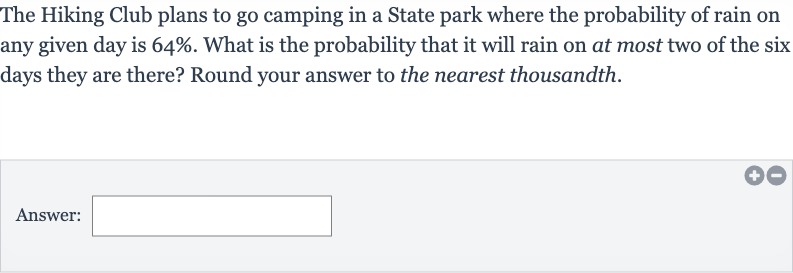AI tutor
Welcome to Bytelearn!
Let’s check out your problem:

The Hiking Club plans to go camping in a State park where the probability of rain on any given day is . What is the probability that it will rain on at most two of the six days they are there? Round your answer to the nearest thousandth.Answer:
Full solution
Q. The Hiking Club plans to go camping in a State park where the probability of rain on any given day is . What is the probability that it will rain on at most two of the six days they are there? Round your answer to the nearest thousandth.Answer:
- Identify probability and days: Identify the probability of rain on any given day and the total number of days.Probability of rain on any given day: or Total number of days: We need to calculate the probability of it raining on at most two of those days.
- Calculate no rain probability: Calculate the probability of it not raining on any given day.Probability of no rain on any given day = Probability of rain on any given day= =
- Use binomial probability formula: Use the binomial probability formula to calculate the probability of it raining on exactly , , and days.The binomial probability formula is , where:- is the probability of successes in trials,- is the binomial coefficient,- is the probability of success on a single trial,- is the probability of failure on a single trial.We will calculate this for , , and .
- Calculate probability for days: Calculate the probability of it raining on exactly days .
- Calculate probability for day: Calculate the probability of it raining on exactly day . =
- Calculate probability for days: Calculate the probability of it raining on exactly days .
- Add probabilities for total: Add the probabilities from steps , , and to find the total probability of it raining on at most days.Total probability = =
- Perform calculations and round: Perform the calculations and round the answer to the nearest thousandth.Total probability Rounded to the nearest thousandth:
More problems from Find probabilities using the binomial distribution
QuestionGet tutor help
QuestionGet tutor help
QuestionGet tutor help
QuestionGet tutor help
QuestionGet tutor help
QuestionGet tutor help
QuestionGet tutor help
QuestionGet tutor help
QuestionGet tutor help
QuestionGet tutor help
